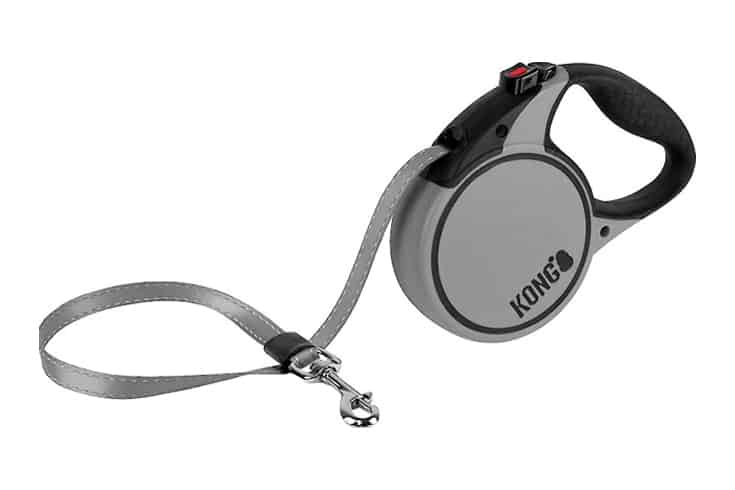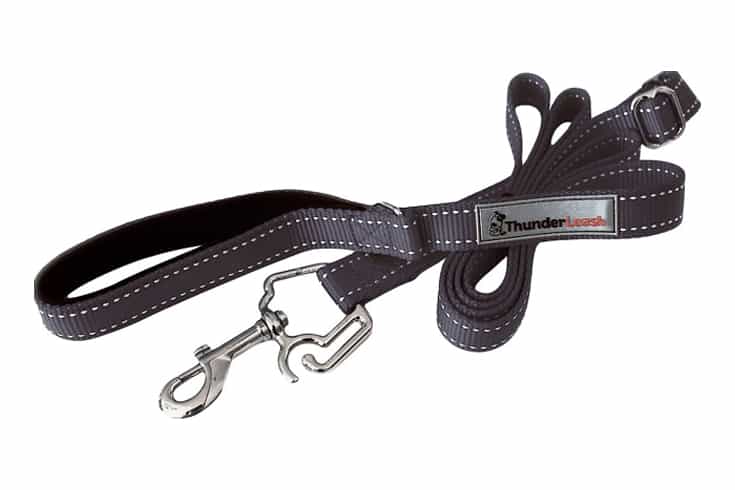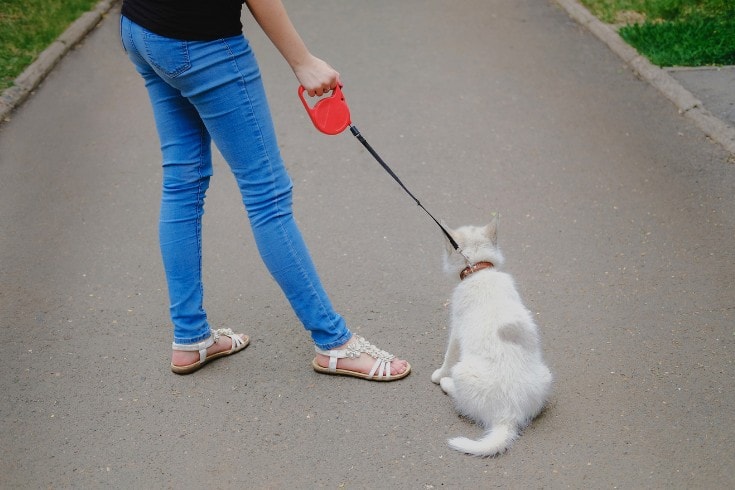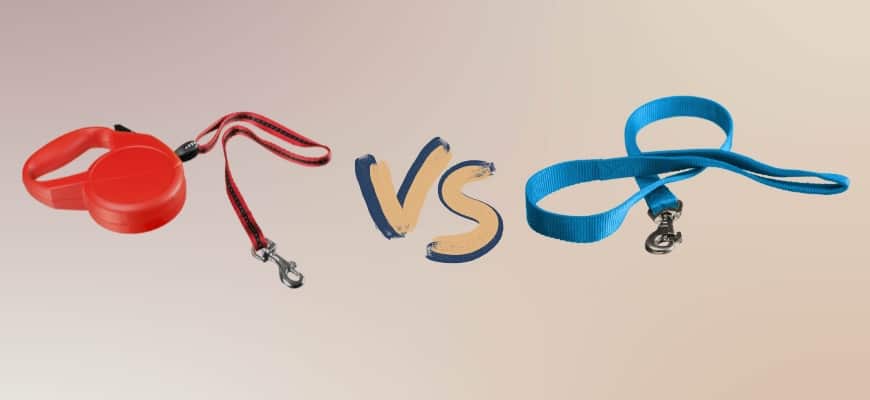[ad_1]
If you want a new leash for your new pet, you need to know which is better; a retractable leash or a regular leash?
Both types of leashes have advantages and disadvantages. However, we think that a regular leash is the safest choice for most dogs.
How so?
Read our guide to the retractable leash vs. the regular leash to find out!
Retractable Leash vs. Regular Leash




– Flexibility: can be extended
– Additional Features like integral flashlights or poop bag holders
– Easy to control your dog
– Good for training your dog to walk beside you
– Safe to dog’s neck or limbs
– Not Suitable for Pullers
– Mechanism Malfunctions
– Danger and accidents can happen
– Lack of versatility, won’t extend
Regular leashes have always been the preferred method of keeping your canine companion by your side. However, retractable leashes have relatively recently become popular.
Let’s compare the two styles of leashes.
What Is a Retractable Leash?


A retractable leash is essentially a leash that’s wound onto a spool and stored inside a large plastic handle. Inside the leash handle is a button that stops the leash line from extending, locking it at the length of the handler’s choice.
Retractable leashes work rather like an extendable tape measure. You can’t reel your dog back in, but the leash will remain taut when you allow your dog to wander around.
Retractable leashes typically extend between 10 and 26 feet. The leash cord material can be very thin nylon and string-like or wider nylon webbing.
A retractable leash is an excellent tool for use in parks and other public spaces where dogs are not permitted to play off-leash. Dogs with poor eyesight can benefit from exercising on a retractable leash since they can enjoy sniffing around and exploring without the risk of getting lost.
What’s a Regular Leash?


Regular leashes can be made from rope, nylon webbing, or leather of various widths and lengths up to around 6 feet. The leash has a looped handle on one end and a metal clip on the other for attachment to the dog’s harness or collar.
Standard leashes come in an array of different colors, weights, and lengths to suit your dog’s needs.
The main drawback to the standard leash is that it does somewhat limit your dog’s freedom. However, this style of leash is perfect for training puppies and older dogs to walk on a loose leash by their owner’s side.
That said, you can buy adjustable leashes that give your dog a little more freedom while having him remain under relatively close control.
Regular Leashes – Pros and Cons
Regular leashes have lots of advantages:
Control
Unlike a retractable leash, a standard leash is short enough to allow you to pull your dog away from unpredictable situations, including strange dogs, loose livestock, and wildlife, and you can also prevent your dog from eating something unpleasant or potentially toxic.
Training


A shorter leash enables you to train your dog to walk obediently beside you. If you tend to walk your dog in an urban area, you can choose a shorter traffic leash that keeps your dog right by your side with no danger of him straying off the curb and into the road.
Safety
There’s no danger of a regular leash becoming entangled around your dog’s neck or limbs. You also won’t need to worry that your dog will rush off in the park and get his leash wrapped around a tree or another dog walker.
Regular leashes often come with Hi-viz, reflective strips, or stitching for safer nighttime walking.
Cleanliness
Unless you have a leather leash, most rope and nylon leashes are washable, so you can get rid of that stinky, doggy odor.
Problem Solving
A regular dog leash will wear out over time. However, any wear and tear are much easier to spot on a standard leash than it is with a retractable one, where damage to the leash cord is usually hidden inside the handle when the leash is wound up.
If a retractable leash gets damaged, the first sign of trouble you’ll get is when the leash breaks and your dog escapes!
But…


Regular leashes have a few drawbacks.
Inflexibility
Probably the worst thing about regular dog leashes is their lack of versatility. If you have a 6-foot leash, it will always be exactly that; a 6-foot leash.
That’s fine in an urban setting when you want to keep your dog under close control. However, if you’re walking in a park or in the wilderness, you can’t let your dog explore and enjoy more freedom.
Although you can buy training or tracking leashes, which are longer, they can be unwieldy to carry around.
Retractable Leashes – Pros and Cons
Retractable leashes also have pros and cons, and we’ll start by looking at the good things about this style of leash.
Flexibility


Unlike regular leashes, retractable leashes can enable your dog to enjoy much more freedom with minimal supervision.
Rather than forcing your furry friend to remain within a few feet of you, a retractable leash allows your dog to roam up to 26 feet away. Your dog can choose whether to wander along behind you or trot on ahead to the end of the leash.
That’s perfect if you have a mannerly dog that won’t charge off away from you. Partially-sighted pups can enjoy a controlled wander without fear of going too far from their handler and getting lost.
You can use a retractable leash in a shorter, locked length in much the same way as a regular leash.
Additional Features
Good quality retractable dog leashes often come with integral flashlights or poop bag holders, which can be handy.
But…
Unfortunately, retractable leashes tend to have more downsides than positives.
Not Suitable for Pullers


Retractable leashes are totally unsuitable for dogs that pull!
A retractable leash works by allowing the dog to enjoy more freedom to roam away from his handler. The dog pulls on the leash, and the spooling mechanism extends the leash cord.
So, the dog quickly learns that he can gain more freedom and get to where he wants to be by pulling on his leash. You don’t want that if your dog tends to pull or you’re trying to leash-train a puppy.
Accidents Happen
The main danger of using retractable leashes is the danger they pose both to dogs and their handlers.
The farther away from you the dog is, the more likely he is to get into mischief and the more difficult it will be for you to grab him.
Your dog could injure another dog or a small child if he charged into them, having reached the end of his leash. An overexcited pup could easily dash out into a busy street, cause an accident, or collide with a cyclist or pedestrian.
Injuries
If a thin leash cord gets tangled around your finger as you try to grab your dog, friction burns, lacerations, and even amputation can happen. A leash cord around your legs could easily cause you to fall, potentially sustaining serious injuries and even broken bones.
Similarly, if the dog gets a limb caught up in the cord, dislocation, amputation, and burns can occur. If the cord ends up around your dog’s neck and he’s too far away for you to intervene quickly, severe injury can result, even strangulation in extreme cases.
Dropped Leash Panic!


Retractable leash handles can’t be wrapped around your hand and can easily be tugged from your grasp if your dog takes off. That often spells big trouble, as the dog thinks the leash handle is pursuing him.
Even worse, when your dog sees the handle is gaining on him, that could send your poor pet into a frenzy and cause him to bolt.
Mechanism Malfunctions
It’s pretty common for the button-locking mechanism on a retractable leash to fail. That can cause the leash to suddenly extend when you don’t want it to, allowing your dog to dash into the street or caper up to another dog.
Sometimes, the button can jam, so you can’t extend the leash at all.
Since the leash cord is hidden inside the plastic handle, it’s impossible for you to see if the cord is damaged. A damaged cord can easily snap under the pressure of your dog pulling on it, potentially allowing your pet to run loose and into danger.
FAQs
In this part of our guide, we answer some of the questions most frequently asked by pet parents considering what leash to buy for their dogs.
Q: Are retractable leashes good for dogs that pull?
A: No. Retractable leashes extend when the dog pulls against them, allowing the dog more freedom.
So, if your dog is a puller, using a retractable leash will effectively dissuade him from walking beside you on a loose leash and, instead, reward him for bad behavior.
Q: Why are retractable leashes controversial?
A: As described above, retractable leashes can encourage a dog to pull against the handler rather than walking obediently beside them.
In addition, if the dog becomes overexcited and dashes away from the handler, the leash can become tangled around the animal’s legs or neck causing injuries. Owners can sustain rope burns if they grab the leash as it extends or even be tugged right off their feet.
Q: What leash is best for a dog that pulls?
A: A regular leash used in combination with a correctly fitting harness is the best choice for a dog that pulls. The harness distributes pressure across the dog’s chest rather than directly on his neck, as is the case when a leash is attached directly to the dog’s collar.
Training aids, such as choke chains, electric collars, and prong collars, work by inflicting pain on the dog’s neck when he pulls. We don’t condone the use of any piece of equipment that causes the dog pain. Pain will make the dog afraid of you, and he might even become afraid of the collar and leash.
Q: What are the pros and cons of retractable leashes?
A: Retractable leashes can be useful if you have a well-behaved or elderly dog that doesn’t pull, tug, or jump up and will come to you when you call. Your dog can enjoy pottering around on the extended leash without wandering too far away from you. That’s ideal in parks or public spaces where off-leash play is not permitted.
However, retractable leashes are unsuitable for pullers or dogs that tend to dash off and refuse to return to their handler. In addition, unruly dogs and their owners can sustain injuries from the thin cord on a retractable leash, especially if the leash becomes tangled around fingers or limbs.
Final Thoughts
Did you find our comparison of retractable and regular leashes helpful? If you did, please share the article before you go.
Our verdict is that if you have a well-mannered, obedient dog that doesn’t pull, jump up, or try to dash off and always comes to call, you might find a retractable leash suitable for your pet. However, a standard leash is the best choice if your dog is a puller or hasn’t learned to walk calmly alongside you.
What type of leash do you use for your dog? Tell us in the comments box below!
[ad_2]
Source link
